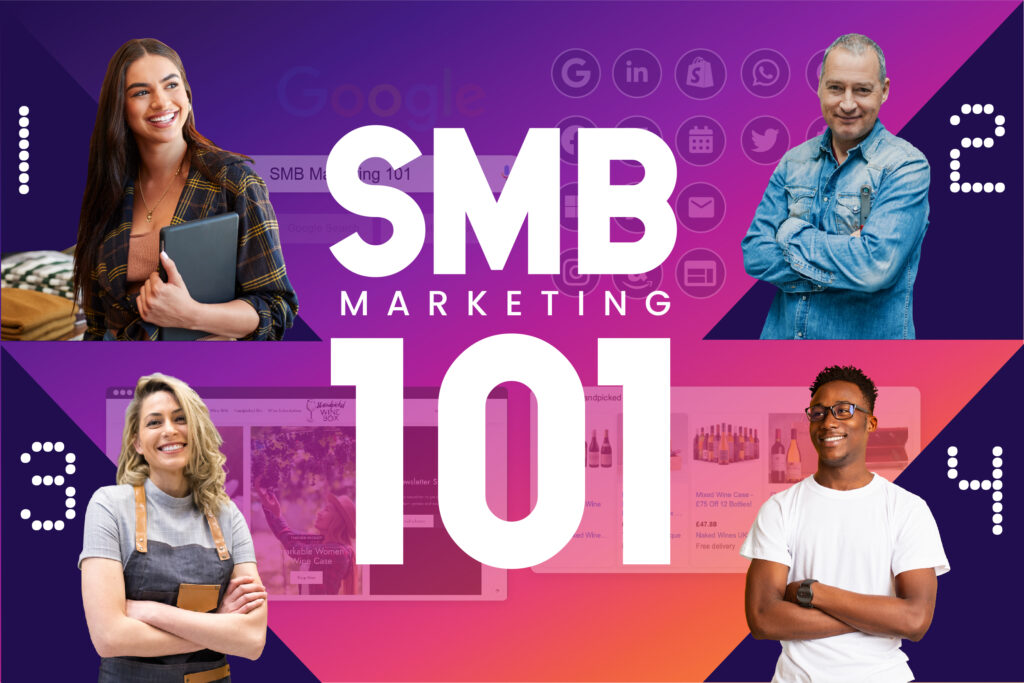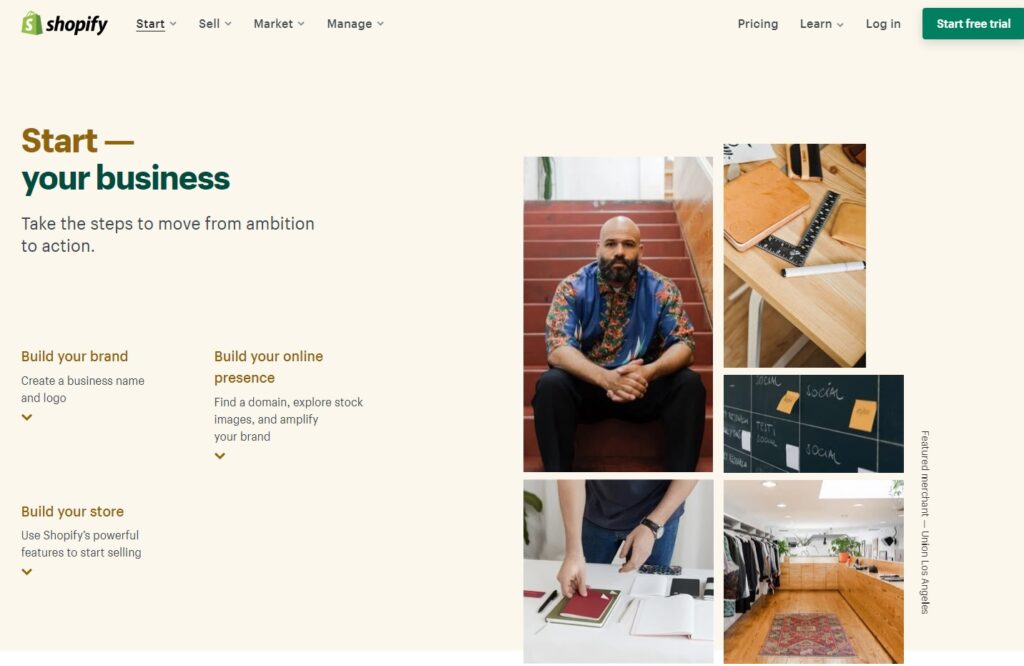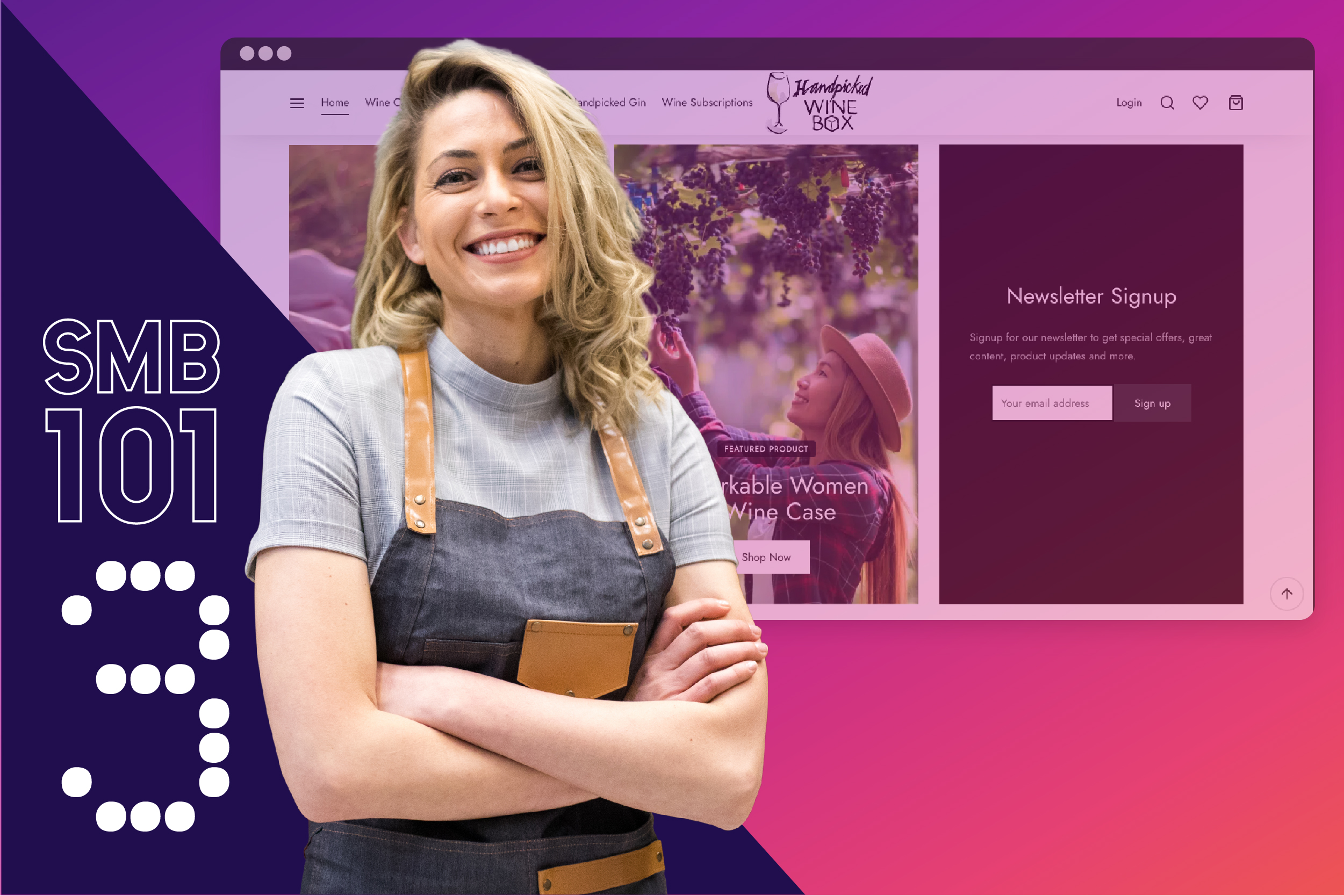Click through for part 1, part 2 or part 4.
For part three, we will look at the steps you should take when you’re getting your brand out to the masses, and we get first-hand insights from SMB owners on how they approached getting online.
In the previous part of this series, we looked at how you can go about developing your brand and how you can select the right digital marketing channel for your business.
So in this part, with all that in place and considered, we’re going to delve more deeply into the first steps you should take when taking your brand online. This part is crucial for laying the solid foundations for your business to thrive online.
From creating your website or getting on a marketplace, to building your social profile and doing the SEO groundwork; we’ll go through it all.
But first, we’re going to look at how best to drive brand awareness in the early stages of your adventure.

Getting your name out there
Before you can start directing traffic anywhere, either through PPC, social media or SEO, you need to start building up your brand’s presence.
In the early days of the internet, people used to be burnt often by scammers, and it made the whole internet population very skeptical. Therefore in 2021, we need to do all we can to quash that skepticism, and we need to build that trust early.
“When a new company comes onto the scene, it’s not necessarily expected that they will start doing a huge number of sales right away,” says Christian Adams, co-founder of Coffee Affection.
“Instead of trying to drive sales, we focused our original digital marketing on just getting our brand name out there. Just getting our company name on people’s radar proved to be a very successful tactic, because when the time came for us to start marketing to drive conversions, it worked out well.”
Customer reviews are crucial here. If you have loads of great reviews on Trustpilot, Google or Facebook, your business is going to look so much more reputable than without. Sure this might not be easy when you aren’t getting many sales, but be creative, and don’t be afraid to ask for them.
“We collected reviews to boost our online credibility,” says the founder of MaxTour, Matthew Meier.
“It took a while to gain some traction, but once we did, we were able to grow our company. Great website, targeted traffic, and lots of online reviews is a fantastic formula for digital marketing success.”
It’s important to note that not every business will need to warm up their leads first. If you’re advertising without a website on somewhere like Amazon or Etsy, then you just need to focus on those customer reviews. But if you do have a site, it’s always advised and will always help the customer trust you if they know who you are before they make a purchase.
There are plenty of ways of doing this. Traditional PR is one way, but another method that is proving really effective in the digital age is blogging/content marketing. The CEO of dontpayfull.com, Andrei Vasilescu, did this in the form of money saving tips:
“We thoroughly researched to find different possible and practical ways to save money in daily, seasonal and occasional purchasing. We started sharing that useful information in the form of interesting articles through our blog page.
“People always search for money saving tricks and they soon found our excellent blog articles in the search results. Our blog contents were the biggest source of online visitors to our business website.”
Content marketing and blogging is a great way of driving traffic to your site and getting yourself recognised as a thought leader in your industry, and the next time the reader sees Andrei’s brand, they’ll automatically associate that with the subject matter they read before.
You can obviously sell within the article too, but even if they don’t convert, the least you’ve done is get great exposure to your brand.
“The most effective technique a business can employ to develop its digital footprint and online reputation is content,” explains Timothy Robinson, the CEO of InVPN.
“We made sure that we had good content to assist our audience to solve their problems, from web copy and social media postings to images and blog entries. We began putting together a solid content marketing strategy. I would suggest not to be afraid to experiment with new content types like videos, infographics, and photos.”
Getting those content pieces to the right audience is a matter of combining this great content with the keyword research we did in part 1, but we’ll get into more of that the Search Engine Optimization (SEO) section coming up.
However, you should also share these pieces with journalists and social media too – just make sure your content is unique, powerful and helpful.
Website Builders
Not all of you will need a website: some of you will already have one, while some of you advertising on the likes of Amazon or Etsy may not feel it’s worth the outlay, so feel free to move on if that’s you.
But if you don’t have one already and you’re not already on a marketplace, make sure you get a website created.
“When it came to our digital marketing, the first thing we did was to get a website,” says Zach Reece, the owner of Colony Roofers.
“We realized that, regardless of the industry you operate in, a website is the most fundamental part of any company’s digital marketing strategy.”
When setting out, it’s hard to look past the website builders of Wix and Shopify. Once upon a time you needed to be well versed in web design and coding. But not anymore, website builders are more than adequate. Actually, they’re pretty fantastic.
Wix is one of the most popular builders out there, and for good reason because it’s super easy for anyone from any background to create a delightful website that looks stunning and works without a hitch.
However, if you’re an ecommerce store, I’d use Shopify. Wix is great if you’re just looking to get a site live which looks nice, but if you’re looking to actually sell things online Shopify is made for that and comes with great ecommerce integrations.
It not only makes it easy to create a website, but it also makes it straightforward to process payments, manage orders and market your business. It’s a killer platform.
They’re both pretty cheap too. Shopify prices start at $29 a month. Wix starts at $18 a month.

What about a Marketplace?
If you’re selling products directly online, it’s very much recommended that you get on a marketplace like Amazon, Ebay or Etsy.
As we alluded to in the last section, you might want to do this instead of creating a website. It can certainly be cheaper, being listed on Amazon for example costs $39.99 per month and there you’ll have access to millions of browsers, whereas with a website you’ll have to pay for the domain registration, hosting, website builder before you even think about getting traffic to your site.
There are considerations to factor in, though, like selling fees and advertising. There are stories out there where businesses have had to sell at a loss just to get brand exposure. We took a real deep dive into all that earlier this year.
My recommendation would be to advertise both on Marketplaces and your own website. Therefore you get the best of both worlds and you’re not solely reliant on the whims of an external company.
And social media?
A few years ago social media used to be sniffed at. But in 2021, social media is the place for pretty much everything, and if you’re not on there, you’re missing out.
You don’t have to be running ads on the platform, but you need a presence as Eric Rohrback, the CMO of Hill & Ponton explains.
“It’s not necessary to be on every social media network; instead, focus on the ones where your prospects spend time. Creating a good Facebook page for your business and regularly providing useful content is the first step toward establishing a strong social media presence.”
And that’s the thing, you don’t have to be posting every day. Just enough to keep your business active. That could be posting your best offers every two or three days. Or something about your company’s culture. Or about something in the news that relates to your business.
Then, once you’re a little more established you can be a little bit more creative.
“I persevered in my attempts to improve the overall quality of the site by developing an online presence and creating profiles on social media sites like Facebook, Instagram, and YouTube,” says David Bitton, the co-founder of DoorLoop.
“I’ve built momentum and buzz for my business by publishing original content relating to my niche on all the different social media sites.”
You can go as hard or as softly as you want, but to begin with, just make sure you’re there. Not sure where to start? Here are the most popular platforms out there:
- Facebook – Facebook has 2.6 billion active users worldwide and is the catchall destination
- Instagram – great for B2C businesses who’s products or services look great to show off in the form of imagery – especially those with millennial or gen z customer bases
- YouTube – another catchall destination, 81% of the US population use YouTube now – but it’s important to note that video is tough to nail
- LinkedIn – perfect for B2B businesses, especially for those of a corporate nature. Full of engaged professionals which 28% of the US population use
- Twitter – a great place to show off your content, especially if you’re a publisher – not always great for engagement, though
- Snapchat & TikTok – the upcoming destinations, great for those aiming at millennials and gen z – just be prepared to get that creative brain whirring
“As a startup company, you should concentrate on a few of them,” says Naomi Stone from Room Service 360.
“Create the content on a regular basis to stay in touch with your audience. Use visuals such as photos and videos to increase engagement. Interact with your audience by responding quickly and resharing. Share industry-related content with your followers.”
Search Engine Optimization (SEO)
If you’re looking for long term results with your website, then it’s hard to look past SEO.
“Our focus from day one was SEO,” says Rahul Mohanachandran, one of the founders of Kasera.
“We accepted that it will lead to slow growth but with a better margin, we invested our time and money into doing everything possible on our website to make it SEO friendly, this includes us founders learning SEO ourselves as well.”
SEO is the practice of optimizing your website and content for search engines. There are few things you have to adhere to: content, page speed, user experience, external links to your website and more.
So taking the content marketing idea we spoke about earlier and combining that with the keyword research you did in part 1, you will therefore be looking at creating a piece of content that resonates with your audience. Say for example you’re a travel business, you may want to create a piece like “the best budget hotels in Boston” for example.
Then by adhering to the principles of best practice, you will eventually go further and further up the rankings if you’re doing everything right and the content is great.
According to Massimo Chieruzzi, digital marketing expert and blogger at divbyzero, “Content Marketing offers an unfair advantage over the long time. Anyone can raise more money and outbid you on paid channels. But SEO takes time and effort, once you dominate your niche, competitors will have a really hard time beating you.”
We have a great SEO ebook for you to go through which details the best practices in a lot more depth. And it’s so worth it your time to learn, because the results are obvious, as many SMB owners I spoke to can attest.
“The bottom line is SEO is everything,” says Bryan Phillips from In Motion Marketing. “Your site and social media need to be built from the ground up with Search Engine Optimization in mind.”
“I work in the review industry, so I knew my first step to market myself was to build up a strong SEO strategy,” says the founder of E-Student, Sander Tamm. “I wanted my target market, looking for in-depth answers about courses they’re interested in, to be able to find me with a quick Google search.”
“I used SEO-optimizing practices to help improve my Google ranking before I even started spending a dime,” says Artem Minaev, the co-founder of FirstSiteGuide. “Keyword research and intelligent keyword insertion into your content can help Googlebots figure out exactly what your content is all about and to which searches it’s most relevant.”
It’s important for me to say this isn’t easy, but it’ll be really worth your time to verse yourself with the basics as detailed out in the ebook, because getting SEO right is SO worth your time.
If you get it right, you’ll be getting “free” clicks to your site forever.
Key takeaways
Start generating great content
- In line with your keyword research, create unique, powerful content that will resonate with your audience
- Contact journalists who write about topics in your industry and ask them to publish your story or write for their website
- Share your articles on social media and optimize them for SEO
Create yourself a website or get on a marketplace. Or both!
- Work out whether you want to have a website or just sell your products on a marketplace
- Use a website builder like Wix or Shopify to get a website set up
- Browse the likes of Amazon, Ebay, Etsy etc. to find out which marketplace is best for you and create a store
Develop a social media presence
- Decide which social media channel is best for your business
- Create a profile on the one best for you
- Start posting content and create unique content to get even more reach
Lay your SEO foundations
- Download and read the SEO ebook to learn the basics of SEO
- Start optimizing your website to follow SEO best practice
- Combine your great content with your keyword research and SEO best practices
Next up…
Now that your online presence has great foundations, you can start thinking about how you can get traffic to your site right here, right now.
We’re going to take a look at the pros and cons of each marketing channel, we’ll hear plenty of opinions from SMB owners on their experiences, we’ll look more in depth at the cost, and provide you with some actionable tips on how to tackle each channel.
Complete the series in part 4!




